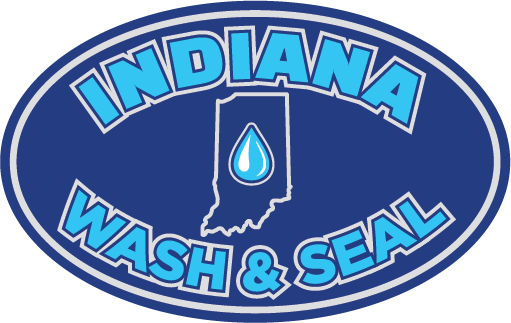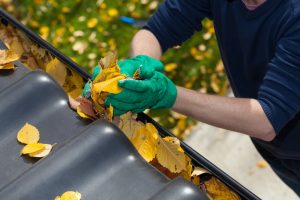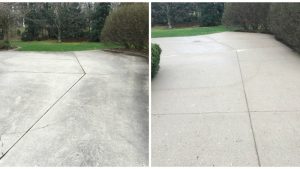Maintaining the appearance of your commercial property is crucial for creating a positive first impression on clients, customers, and tenants. Over time, dirt, grime, mold, and other contaminants can accumulate on exterior surfaces, diminishing the overall look of your building. Pressure washing is an effective solution for removing these impurities, restoring your property’s curb appeal, and prolonging the lifespan of your surfaces. Proper preparation is key to ensuring a successful pressure-washing process. This guide will walk you through the steps necessary to prepare your commercial property for a professional pressure wash.
Understanding the Importance of Pressure Washing
Pressure washing your commercial property will introduce you and your employees to many benefits. Our friends at Mr. Handyman have provided us with some of those benefits.
1. Enhancing Curb Appeal
A clean, well-maintained exterior enhances the visual appeal of your property, making it more attractive to potential clients and tenants. Pressure washing removes unsightly stains, mold, mildew, and dirt, giving your building a fresh, clean appearance.
2. Preventing Damage
Over time, contaminants like mold, algae, and mildew can cause structural damage to your building. Regular pressure washing prevents the buildup of these harmful substances, protecting your property from deterioration and costly repairs.
3. Promoting Health and Safety
Mold, mildew, and algae can pose health risks to occupants and visitors. Pressure washing eliminates these hazards, promoting a healthier environment. Additionally, clean walkways and entryways reduce the risk of slips and falls.
4. Maintaining Property Value
A well-maintained property retains its value and can even increase over time. Regular pressure washing is a cost-effective way to protect your investment and ensure your property remains in top condition.
Steps to Prepare Your Commercial Property for Pressure Washing
1. Evaluate the Property
Before scheduling a pressure washing service, conduct a thorough evaluation of your property. Identify the areas that need cleaning, such as building exteriors, sidewalks, parking lots, roofs, and windows. Take note of any specific stains, mold, or mildew that require attention.
2. Hire a Professional Service
Choose a reputable, experienced pressure washing company to handle the job. Look for companies that specialize in commercial properties and have positive reviews from previous clients. Ensure they are licensed, insured, and use environmentally friendly cleaning solutions.
3. Notify Occupants and Stakeholders
Inform your tenants, employees, and other stakeholders about the upcoming pressure washing service. Provide details on the schedule, areas to be cleaned, and any necessary precautions. This helps minimize disruptions and ensures everyone is prepared for the cleaning process.
4. Secure and Protect Property
To prevent damage and ensure a smooth cleaning process, take the following steps to secure and protect your property:
a. Remove Obstacles
Clear the areas to be pressure washed of any obstacles, such as outdoor furniture, planters, trash cans, and signage. This allows the cleaning crew to access all surfaces easily and ensures a thorough cleaning.
b. Cover Delicate Plants and Landscaping
Protect delicate plants and landscaping features by covering them with tarps or plastic sheeting. This prevents damage from the high-pressure water and cleaning solutions.
c. Seal Windows and Doors
Ensure all windows and doors are tightly closed to prevent water from entering the building. Check for any gaps or leaks and seal them if necessary.
d. Turn Off Electrical Equipment
Turn off any outdoor electrical equipment and outlets in the areas to be cleaned. Cover them with waterproof plastic to prevent water damage.
e. Protect HVAC Units
Cover HVAC units and other sensitive equipment to shield them from high-pressure water and cleaning agents. Ensure proper ventilation to avoid overheating.
f. Remove Vehicles
If the parking lot or garage is being cleaned, remove all vehicles from the area. Arrange alternative parking for tenants and employees if necessary.
5. Conduct a Pre-Inspection
Before the pressure washing begins, conduct a pre-inspection with the cleaning crew. Walk through the property, pointing out specific areas of concern and any delicate surfaces that require special attention. This ensures the crew is aware of your expectations and can address any potential issues.
6. Document the Condition
Take photographs of the property before the pressure washing begins. This provides a record of the pre-existing condition and can be useful for addressing any issues that arise during or after the cleaning process.
7. Prepare for Post-Cleaning Maintenance
Once the pressure washing is complete, there may be some post-cleaning maintenance required. Prepare for this by having cleaning supplies on hand to wipe down windows, doors, and other surfaces that may have been splashed during the process. Check for any areas that may need touch-ups or additional cleaning.
Choosing the Right Pressure Washing Techniques
Different surfaces and contaminants require different pressure-washing techniques. Discuss these options with your chosen service provider to ensure the best results:
1. Soft Washing
Soft washing is a low-pressure technique that uses specialized cleaning solutions to remove dirt, mold, and algae. It is ideal for delicate surfaces like stucco, wood, and painted exteriors, as it reduces the risk of damage.
2. High-Pressure Washing
High-pressure washing uses a strong stream of water to remove tough stains, grime, and debris. It is suitable for hard surfaces like concrete, brick, and asphalt. However, it should be used with caution on more delicate surfaces to avoid damage.
3. Hot Water Washing
Hot water washing combines high pressure with hot water to effectively remove grease, oil, and other stubborn contaminants. It is especially useful for cleaning parking lots, driveways, and areas with heavy traffic.
4. Eco-Friendly Solutions
Choose a pressure washing service that uses eco-friendly, biodegradable cleaning solutions. These products are effective at removing contaminants while being safe for the environment and surrounding landscaping.
Post-pressure washing Care and Maintenance
1. Inspect the Property
After the pressure washing is complete, conduct a thorough inspection of the property. Check for any areas that may need additional cleaning or touch-ups. Ensure all surfaces are clean and free of debris.
2. Remove Protective Covers
Carefully remove any tarps, plastic sheeting, or covers from plants, landscaping, and sensitive equipment. Dispose of or store them for future use.
3. Restore Outdoor Furniture and Items
Return outdoor furniture, planters, signage, and other items to their original positions. Ensure they are clean and dry before placing them back in the area.
4. Monitor for Issues
Keep an eye on the property for any issues that may arise after the pressure washing. Address any concerns promptly to maintain the appearance and integrity of your building.
5. Regular Maintenance Schedule
Establish a regular maintenance schedule to keep your property looking its best. Periodic pressure washing, combined with routine cleaning and inspections, will help preserve the appearance and value of your commercial property.
Conclusion
Preparing your commercial property for a pressure wash involves careful planning, coordination, and attention to detail. By following these steps, you can ensure a smooth and successful cleaning process that enhances the appearance, safety, and value of your property. Regular pressure washing is an essential part of property maintenance, helping to protect your investment and create a positive impression on clients, tenants, and visitors. With the right preparation and professional service, your commercial property will look clean, inviting, and well-maintained for years to come.



